LG Electronics LFC21776ST User Manual

ESPAÑOL FRANÇAIS ENGLISH
OWNER’S MANUAL
FRENCH DOOR
REFRIGERATOR
Please read this guide thoroughly before operating and keep it handy for reference at all times.
LFC25776**
LFC21776**
P/No. : MFL63728505 |
www.lge.com |
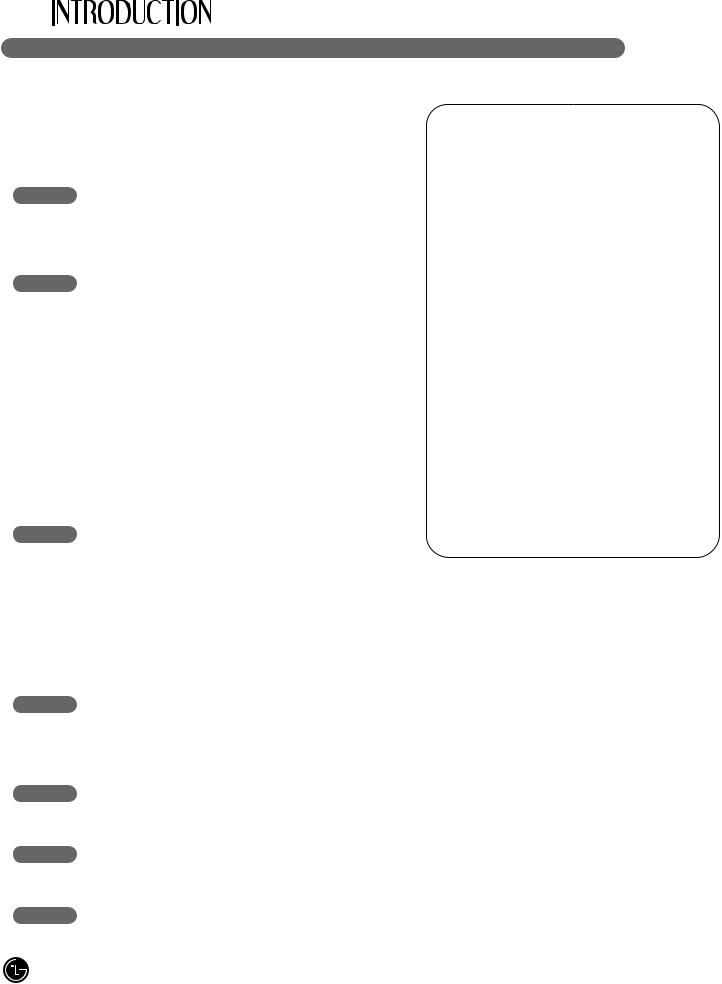
 IMPORTANT SAFETY INFORMATION
IMPORTANT SAFETY INFORMATION
Basic Safety Precautions ........................................ |
3 |
CFC Disposal .......................................................... |
4 |
How to Connect Electricity ...................................... |
5 |
PARTS AND FEATURES |
|
Special Features ..................................................... |
6 |
Key Parts and Components .................................... |
7 |
INSTALLATION |
|
Choose the Proper Location ................................... |
8 |
Clearances .............................................................. |
8 |
Flooring ................................................................... |
9 |
Handle Removal...................................................... |
9 |
Refrigerator Door and Freezer Drawer Removal .. |
10 |
Light Replacement ................................................ |
15 |
Connecting the Water Supply ............................... |
16 |
Connecting the Water Lines.................................. |
17 |
Leveling the Refrigerator Doors ............................ |
18 |
Starting.................................................................. |
19 |
HOW TO USE |
|
Setting The Controls ............................................. |
20 |
Automatic Icemaker ............................................. |
21 |
Storing Foods ....................................................... |
22 |
Location of Foods ................................................. |
23 |
Shelf Height Adjustment ....................................... |
24 |
Removing and Replacing Components ................ |
25 |
CARE AND CLEANING |
|
Cleaning the Refrigerator ..................................... |
29 |
General Information ............................................. |
29 |
TROUBLESHOOTING
Before Calling for Service …………………………30
SPECIFICATIONS
Key Dimensions and Specifications ..................... |
34 |
WARRANTY
THANK YOU!
Congratulations on your purchase
and welcome to the LG family.
Your new LG French Door Refrigerator combines
advanced cooling technology
with simple operation and high
efficiency. Follow the operating
and care instructions in this
manual and your refrigerator
will provide you with many years
of reliable service.
Product Registration Information .......................... |
35 |
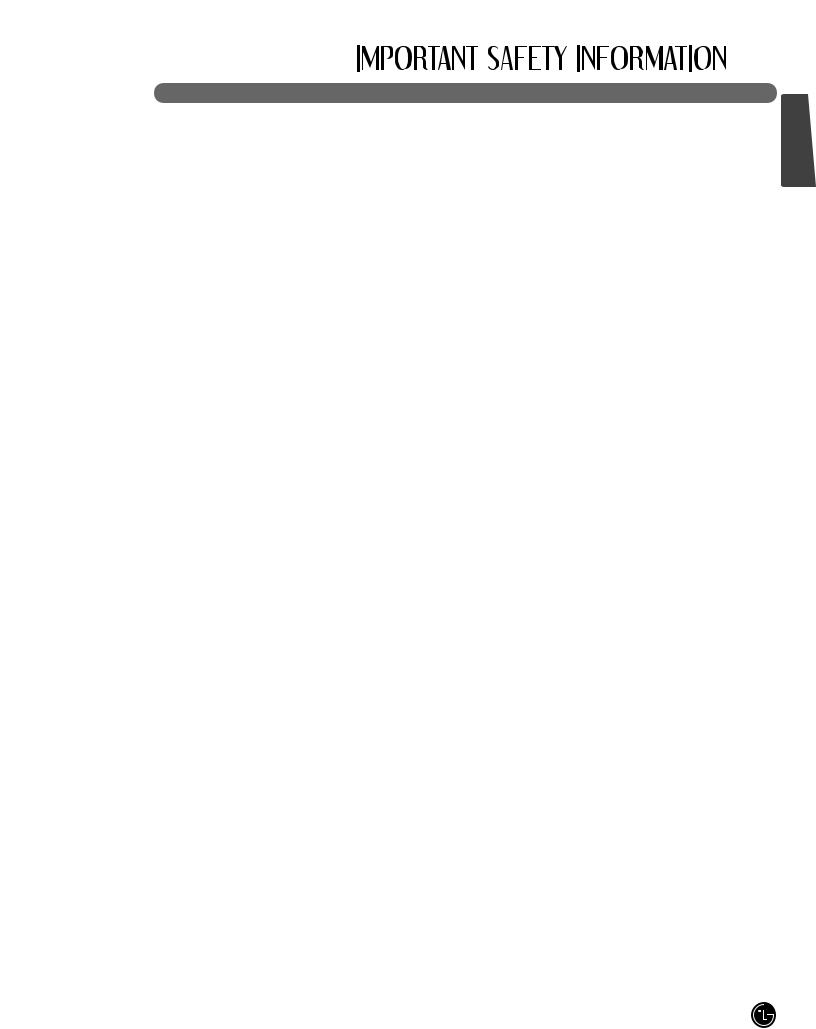
 BASIC SAFETY PRECAUTIONS
BASIC SAFETY PRECAUTIONS
This guide contains many important safety messages. Always read and obey all safety messages.
w This is the safety alert symbol. It alerts you to safety messages that inform you of hazards that can kill or hurt you or others or cause damage to the product. All safety messages will be preceded by the safety alert symbol and the hazard signal word DANGER, WARNING, or CAUTION. These words mean:
wDANGER wWARNING
wCAUTION
You might be killed or seriously injured if you don’t follow instructions.
You can be killed or seriously injured if you don’t follow instructions.
Indicates an imminently hazardous situation which, if not avoided, may result in minor or moderate injury, or product damage.
All safety messages will identify the hazard, tell you how to reduce the chance of injury, and tell you what can happen if the instructions are not followed.
ENGLISH
wWARNING
To reduce the risk of fire, electric shock, or injury to persons when using your product, basic safety precautions should be followed, including the following.
Read all instructions before using this appliance.
•NEVER unplug your refrigerator by pulling on the power cord. Always grip the plug firmly and pull it straight out from the outlet.
•Repair or replace immediately all electric service cords that have become frayed or otherwise damaged. Do not use a cord that shows cracks or abrasion damage along its length or at either the plug or connector end.
•When moving your refrigerator away from the wall, be careful not to roll over or damage the power cord.
•DO NOT store or use gasoline or other flammable vapors and liquids in the vicinity of this or any other appliance.
•DO NOT allow children to climb, stand, or hang on the refrigerator doors or shelves in the refrigerator. They could damage the refrigerator and seriously injure themselves.
•Keep fingers out of pinch point areas; clearances between the doors and cabinet are necessarily small. Be careful closing doors when children are in the area.
•Unplug your refrigerator before cleaning or making any repairs.
NOTE: Service should be performed by a qualified technician.
•Before replacing a burned-out light bulb, unplug the refrigerator or turn off power at the circuit breaker or fuse box in order to avoid contact with a live wire filament. (A burned-out light bulb may break when being replaced.)
NOTE: Some models have LED interior lighting and service should be performed by a qualified technician.
NOTE: Setting either or both controls to the OFF position does not remove power to the light circuit.
•When you are finished, reconnect the refrigerator to the electrical source and reset the control (Thermostat Refrigerator Control, or Freezer Control, or Freezer Control, depending on the model) to the desired setting.
•This refrigerator must be properly installed in accordance with the Installer Instructions that were taped to the front of the refrigerator.
•After your refrigerator is in operation, do not touch the cold surfaces in the freezer compartment when hands are damp or wet. Skin may adhere to the extremely cold surfaces.
•In refrigerators with automatic icemakers, avoid contact with the moving parts of the ejector mechanism or with the heating element that releases the cubes. DO NOT place fingers or hands on the automatic icemaking mechanism while the refrigerator is plugged in.
•Do not modify or extend the power cord length.
It will cause electric shock or fire.
3
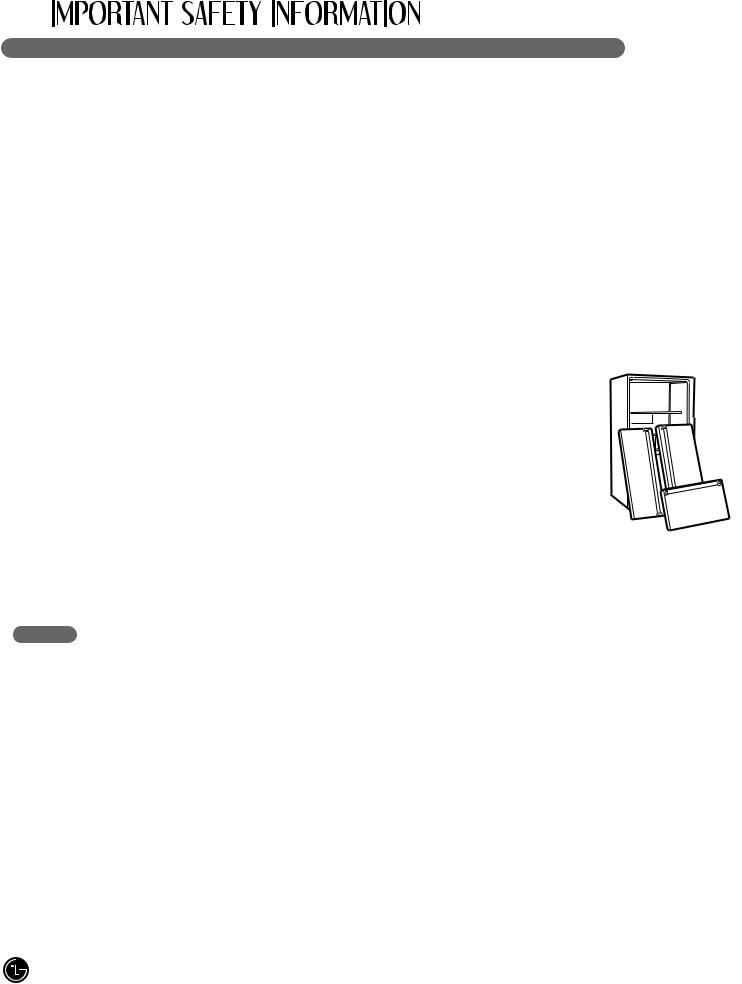
 BASIC SAFETY PRECAUTIONS (CONT.)
BASIC SAFETY PRECAUTIONS (CONT.)
•Do not use drier to dry the inside, nor light a candle to remove odor.
•Install in places away from the fire such as the place where flammable gas is leaked.
•This appliance is not intended for use by persons (including children) with reduced physical, sensory or mental capabilities, or lack of experience and knowledge, unless they have been given supervision or instruction concerning use of the appliance by a person responsible for their safety.
Children should be supervised to ensure that they do not play with the appliance.
•DO NOT refreeze frozen foods which have thawed completely. The United States Department of Agriculture in Home and Garden Bulletin No. 69 says:
…You may safely refreeze frozen foods that have thawed if they still contain ice crystals or if they are still cold—below 40°F (4°C).
…Thawed ground meats, poultry, or fish that have any off-odor or off-color should not be refrozen and should not be eaten. Thawed ice cream should be discarded. If the odor or color of any food is poor or questionable, dispose of it. The food may be dangerous to eat.
Even partial thawing and refreezing reduces the quality of foods, particularly fruits, vegetables, and prepared foods. The eating quality of red meats is affected less than that of many other foods. Use refrozen foods as soon as possible to save as much of their quality as you can.
Risk of Child Entrapment
Discarded or abandoned refrigerators are dangerous, even if they will sit for just a few days. If you are disposing of your old refrigerator,
please follow the instructions below to help prevent accidents.
Before you throw away your old refrigerator or freezer:
•Take off the doors.
•Do not leave the shelves
in place, as children may climb inside.
CFC DISPOSAL
Your old refrigerator may have a cooling system that used CFCs (chlorofluorocarbons). CFCs are believed to harm stratospheric ozone.
If you are throwing away your old refrigerator, make sure the CFC refrigerant is removed for proper disposal by a qualified servicer. If you intentionally release this CFC refrigerant, you can be subject to fines and imprisonment under provisions of environmental legislation.

 HOW TO CONNECT ELECTRICITY
HOW TO CONNECT ELECTRICITY
IMPORTANT: Please read carefully.
wWARNING
Electrical Shock Hazard
For personal safety, this appliance must be properly grounded. Have the wall outlet and the circuit checked by a qualified electrician to make sure the outlet is properly grounded.
RECOMMENDED GROUNDING METHOD
The refrigerator should always be plugged into its own individual properly grounded electrical outlet rated for 120 volts, 60 Hz, AC only, and fused at 20 amperes. This provides the
best performance and also prevents overloading house wiring circuits which could cause a fire hazard from overheated wires. It is recommended that a separate circuit serving only this appliance be provided.
Use a receptacle which cannot be turned off with a switch or pull chain. Do not use an extension cord. Where a standard two-prong wall outlet is encountered, it is your personal responsibility and obligation to have it replaced with a properly grounded three-prong wall outlet.
Do not, under any circumstances, cut or remove the third (ground) prong from the power cord.
Do not use an adapter plug.
NOTE: Some models have LED interior lighting and service should be performed by a qualified technician.
When you are finished, reconnect the refrigerator to the electrical source and reset the control (Thermostat, Refrigerator Control, or Freezer Control, depending on the model) to the desired setting.
USE OF EXTENSION CORDS
Because of potential safety hazards under certain conditions, we strongly recommend against the use of an extension cord.
However, if you still elect to use an extension
cord, it is absolutely necessary that it be a UL-listed (USA), 3-wire grounding-type appliance
extension cord having a grounding-type plug and outlet and that the electrical rating of the cord be 20 amperes (minimum) and 120 volts.
Use of an extension cord will increase the clearance needed for the back of the refrigerator.
SAVE THESE INSTRUCTIONS
ENGLISH
5 
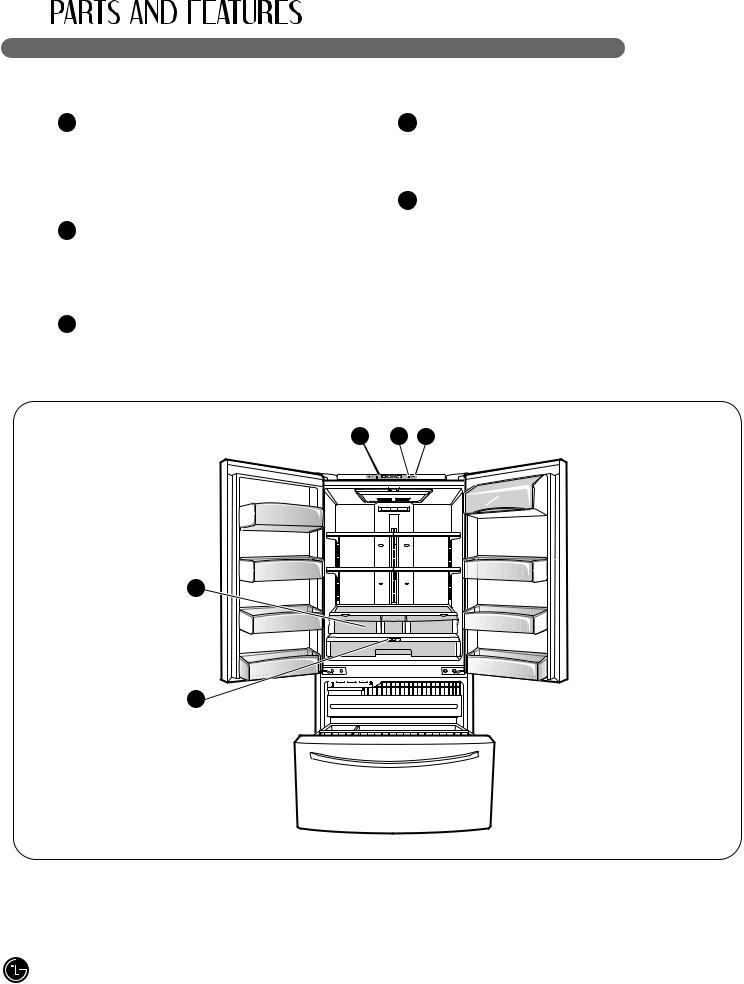
 SPECIAL FEATURES
SPECIAL FEATURES
1 |
4 |
|
Simple electronic controls are user-friendly. |
|
LG’s crispers preserve humidity and help vegetables |
The LED screen shows refrigerator and freezer |
|
stay crisp. |
temperatures, displays water filter status, |
|
|
dispenser information, and more. |
5 |
GLIDE‘N’SERVE |
|
ICE PLUS
When this feature is activated, the freezer section will run at the coldest temperature for a 24hour period to increase ice production.
Provides storage space with a variable temperature control that keeps the compartment colder than refrigerator.
3
A warning alarm sounds at 30-second intervals when the refrigerator or freezer door is left open for more than 60 seconds.
1 |
2 |
3 |
4 |
|
|
5 |
|
|
NOTE: This guide covers several different models.
The refrigerator you have purchased may have some or all of the items listed below. The locations of the features shown below may not match your model.

 KEY PARTS AND COMPONENTS
KEY PARTS AND COMPONENTS
In addition to the special features and components outlined in the Special Features section, there are several other important components that are referenced in this manual.
1 |
|
3 |
STORAGE BIN |
|
The refrigerator compartment shelves are |
|
The ice storage bin can be removed to fill ice |
|
adjustable to allow flexibility for storage needs. |
|
buckets, coolers, or pitchers. |
2 |
GALLON STORAGE BINS |
4 |
LED INTERIOR LAMPS |
|
Three interchangeable bins can be arranged to |
|
Refrigerator interior is lit by the LED array. |
|
suit your storage needs. |
|
|
5 FIXED DOOR BINS
|
4 |
|
1 |
2 |
2 |
5 |
5 |
|
|
3 |
|
ENGLISH
7 

 CHOOSE THE PROPER LOCATION
CHOOSE THE PROPER LOCATION
wWARNING
Excessive Weight Hazard
Two or more people are required when moving and unpacking the appliance.
•Store and install the refrigerator where it will not be exposed to temperatures below freezing or exposed to outdoor weather conditions.
•Install this appliance in an area where the temperature is between 55°F (13°C) and 110°F (43°C). If the temperature around the appliance is too low or too high, cooling ability may be adversely affected.
•If this refrigerator is installed where the temperature is above 110°F (43°C), the freezing capacity is compromised and the cost of electricity used increases.
CLEARANCES
 2" (5.08 cm)
2" (5.08 cm)
•To reduce the risk of electric shock, do not install the refrigerator in a wet or damp area.
•Select a place where a water supply can be easily connected for the automatic icemaker and dispenser.
•Unstable installation may cause vibration and noise. If the floor is not even, make the refrigerator level by rotating the height adjusting screws.
•Properly ground the refrigerator to conform with all governing codes and ordinances.
wCAUTION
Avoid placing the unit near heat sources, direct sunlight, or moisture.
•Too small a distance from adjacent items may result in lowered freezing capability and increased electricity consumption charges. Allow at least 24 in. (61 cm) in front of the refrigerator to open the doors.
NOTE: For complete dimensions and specifications, see page 34.
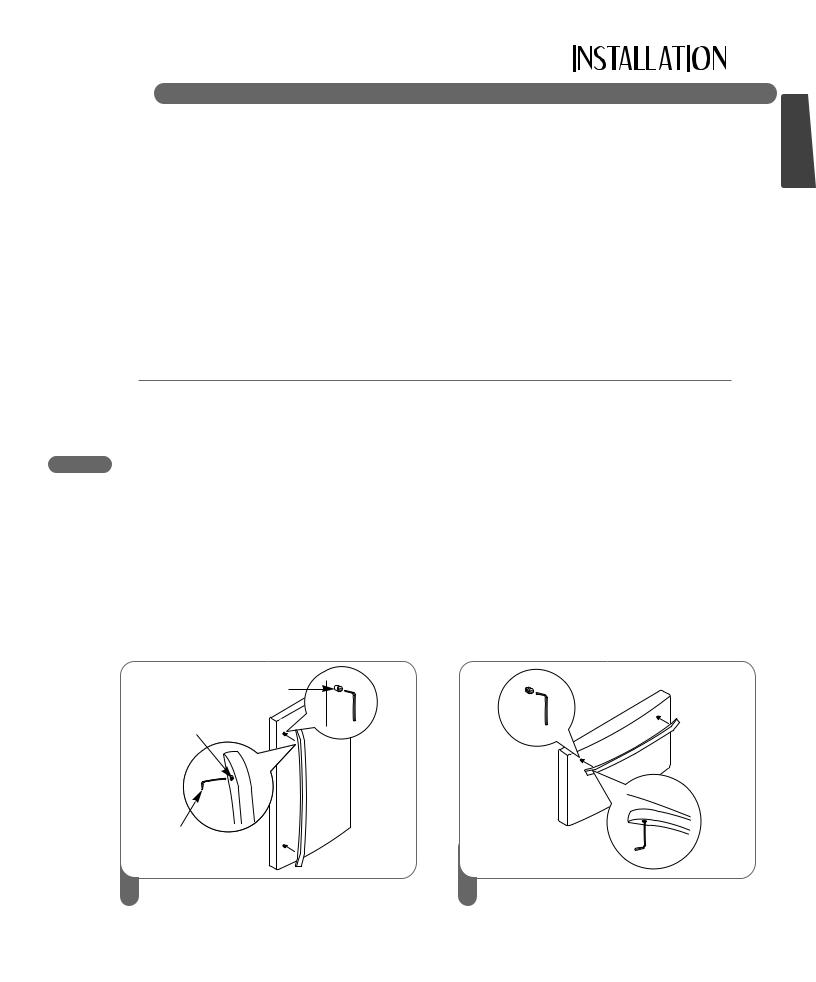
 FLOORING
FLOORING
•To minimize noise and vibration, the refrigerator MUST be installed on a solidly constructed floor.
•To avoid vibration, the unit must be level.
If required, adjust the leveling legs to compensate for unevenness of the floor. The front should be slightly higher than the rear to aid in door closing. The leveling legs can be turned easily
by pushing against the top of the refrigerator to take the weight off the feet. Turn the leveling legs clockwise to raise the unit or counterclockwise to lower it.
•Carpeting and soft tile surfaces are not recommended.
•Never install the refrigerator on a platform or weakly supported structure.
NOTE: When moving the refrigerator for cleaning or service, be sure to protect the floor. Always pull the refrigerator straight out when moving it.
Do not wiggle or walk the refrigerator when trying to move it; floor damage could occur.
NOTE: It is recommend that the doors be removed when it is necessary to move the refrigerator through a narrow opening.
HANDLE REMOVAL
To move the refrigerator through a house door, it may be necessary to remove the refrigerator door handles.
NOTE: Handle appearance may vary from illustrations on this page.
wCAUTION
•Use special care when removing handles to prevent scratching the doors.
•The handle could be damaged if you hit it with a hammer while removing or attaching.
•When you assemble or disassemble a handle, you must push or pull with reasonable force.
Mounting
Fasteners
Set Screw
Allen Wrench
1 |
2 |
ENGLISH
9 

 HANDLE REMOVAL (CONT.)
HANDLE REMOVAL (CONT.)
HANDLE REINSTALLATION
Mounting
Fasteners
1 |
2 |
DOOR AND FREEZER DRAWER REMOVAL
DOOR REMOVAL
WARNING
Shock Hazard
electrical supply to the refrigerator installing. Failure to do so could result in or serious injury.
not put hands or feet or metal sticks into the air base grille, or bottom of the refrigerator. You
be injured or receive an electrical shock.
careful when you work with the hinge, base and stopper. You may be injured.
you begin, remove food and bins from the
.
entrance door is too narrow for the refrigerator through, remove the refrigerator door and
the refrigerator sideways through the doorway.

 REFRIGERATOR DOOR AND FREEZER DRAWER REMOVAL (CONT.)
REFRIGERATOR DOOR AND FREEZER DRAWER REMOVAL (CONT.)
REFRIGERATOR DOOR REMOVAL (CONT.)
(2)(1)
(2)
(1)
(5) (6)
(7)
|
|
(4) |
|
|
|
(3) |
(4) |
|
|
|
|
|
(5) |
|
(3) |
|
|
|
|
1 |
|
|
2 |
ENGLISH
11 
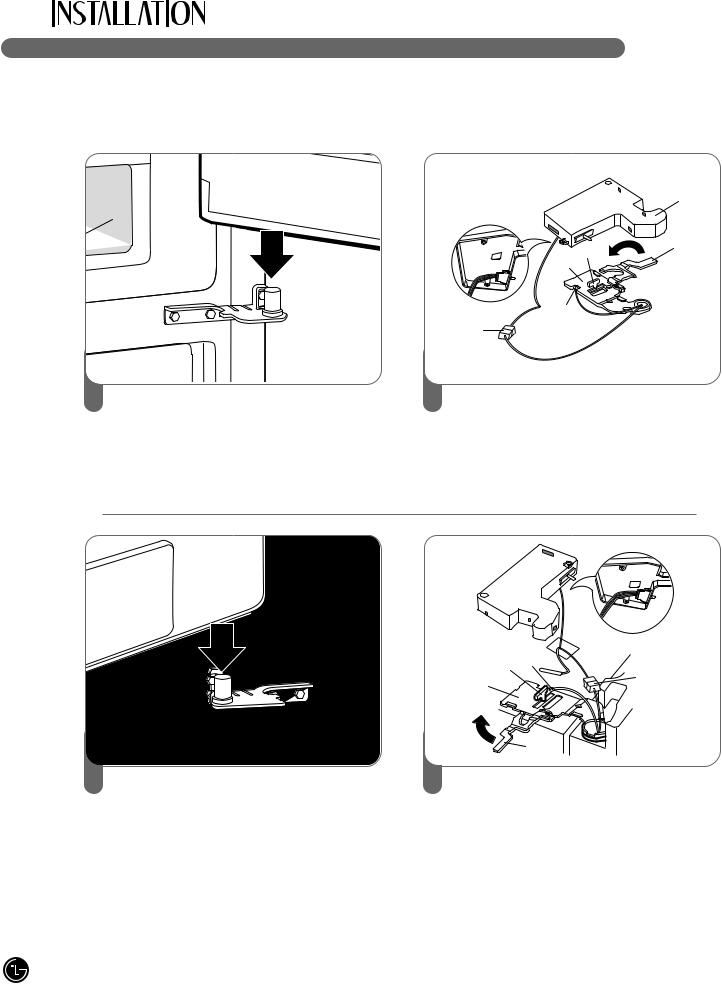
 REFRIGERATOR DOOR AND FREEZER DRAWER REMOVAL (CONT.)
REFRIGERATOR DOOR AND FREEZER DRAWER REMOVAL (CONT.)
REFRIGERATOR DOOR REINSTALLATION
|
(2) |
(2) |
(3) |
|
(1)
 (4)
(4)
(5)
1 |
2 |
|
(2) |
(4) |
|
(5) |
|
(1) |
|
|
|
|
3 |
4 |
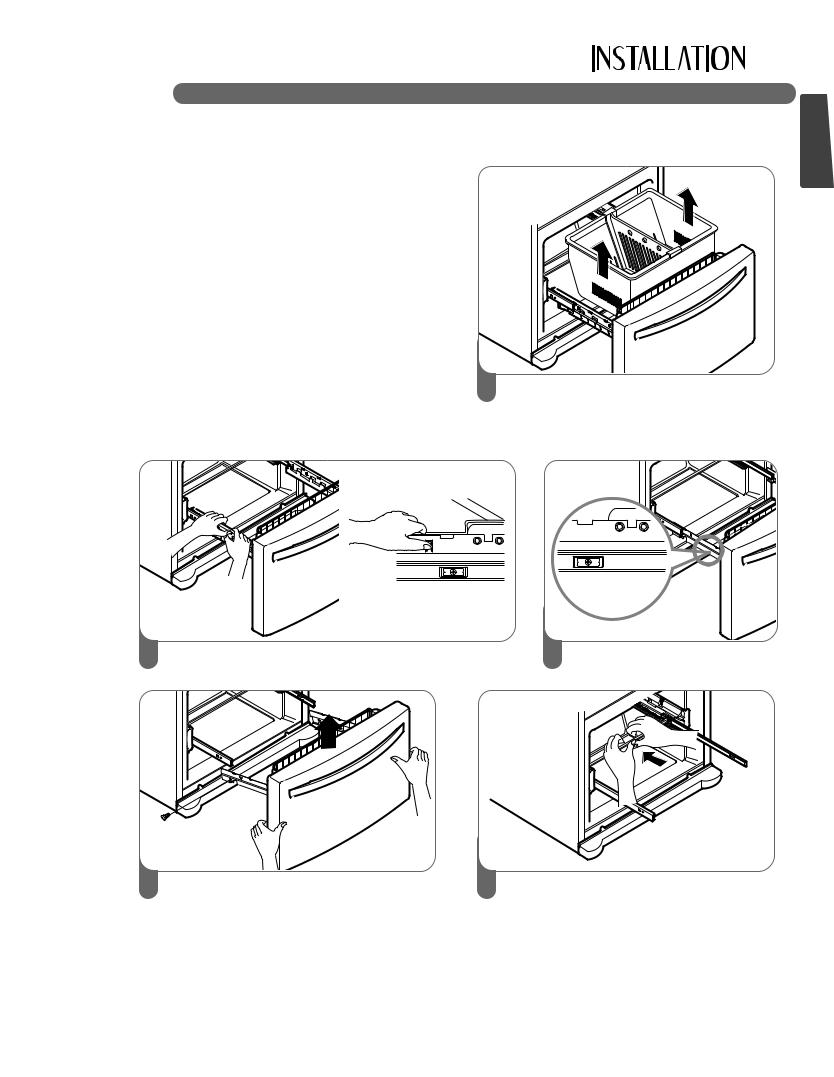
 REFRIGERATOR DOOR AND FREEZER DRAWER REMOVAL (CONT.)
REFRIGERATOR DOOR AND FREEZER DRAWER REMOVAL (CONT.)
FREEZER DRAWER REMOVAL
wCAUTION
• Care should be taken to avoid product or property damage when removing the freezer door. It maybe necessary to have assistance with the following insturctions.
• To avoid damage do not hold the handle when removing the door. It could come off and cause and injury.
1
ENGLISH
2 |
3 |
4 |
5 |
flex the center bar enough |
|
|
on both ends to release |
|
|
from the track. |
wCAUTION: When you remove the drawer, do not hold |
|
. If it may come off and it could cause |
personal injury. |
|
|
wCAUTION: When placing the drawer on the floor, care should be taken to avoid floor damage.
13 
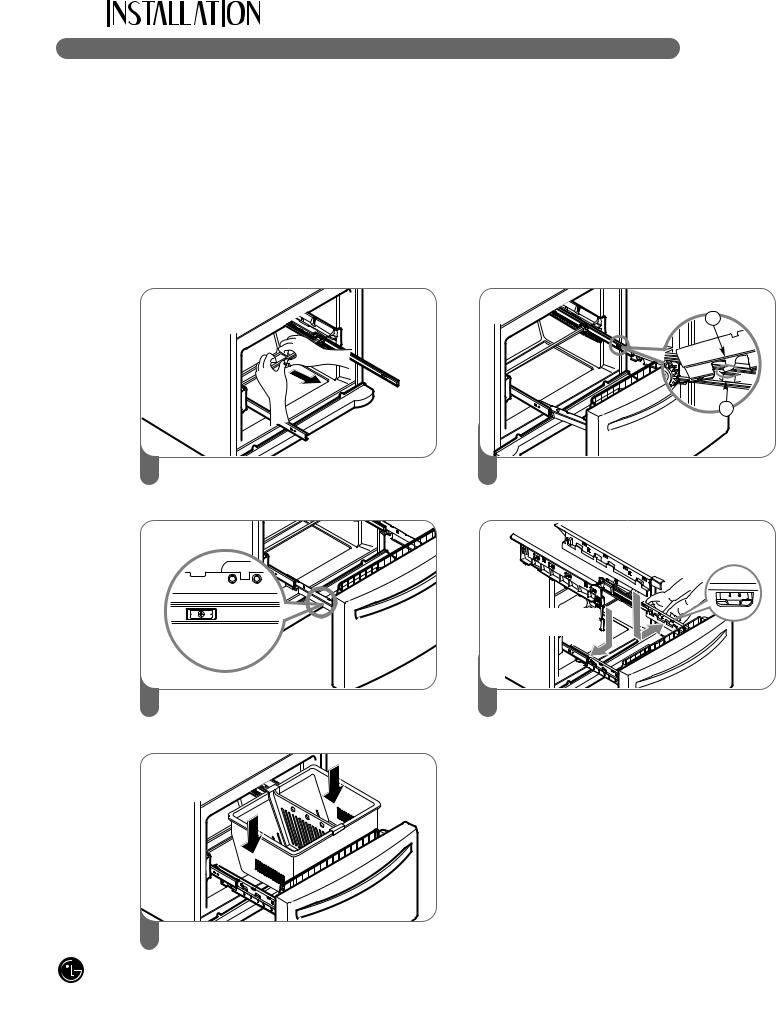
 REFRIGERATOR DOOR AND FREEZER DRAWER REMOVAL (CONT.)
REFRIGERATOR DOOR AND FREEZER DRAWER REMOVAL (CONT.)
FREEZER DRAWER REINSTALLATION
wCAUTION
•To avoid possible injury or product or property damage, you will need two people to perform the following instructions. It maybe necessary to have assistance with the following instructions.
wWARNING
Risk of Child Entrapment
•To prevent accidental child and pet entrapment or suffocation risk, DO NOT allow them to play inside of the freezer drawer.
•DO NOT step or sit on the freezer drawer.
1
2
1 |
2 |
Right
Rail Cover
Assembly Hole
Left
Rail Cover
3 |
4 |
WARNING: To prevent accidental child and pet entrapment or suffocation risk.
DO NOT allow them to play inside of drawer.
WARNING: DO NOT step or sit down on freezer.
5

 LIGHT REPLACEMENT
LIGHT REPLACEMENT
To Change Refrigerator Light
This model has special LED interior lighting and service should be performed by a qualified technician.
wWARNING
Electrical Shock Hazard
Before replacing a burned-out light bulb, either unplug the refrigerator or turn off power at the circuit breaker or fuse box.
NOTE: Moving the control to the OFF position does not remove power to the light circuit.
NOTE:
•Not all appliance bulbs will fit your refrigerator. Be sure to replace the bulb with one of the same size, shape and wattage.
•The light bulbs will turn off if door is left open for seven continuous minutes. Shutting door for one second will light bulbs to come back on.
To Change Freezer Light
1.Unplug refrigerator power cord form outlet.
2.Use a screwdriver to remove the cover screw. (Save the cover screw)
3. Using a flat instru gently pry the la loose in the front shown. Rotate
to remove the rear
4.Make sure the cool to the touch
Turn the bulb counterclockwise remove.
5. Replace with a
60-watt appliance
6. Insert tabs on back cover into slots in ceiling. Push cover snap front into
7. Use a screwdriver to asse
wCAUTION
•DO NOT place fingers Lamp may be hot.
ENGLISH
15 
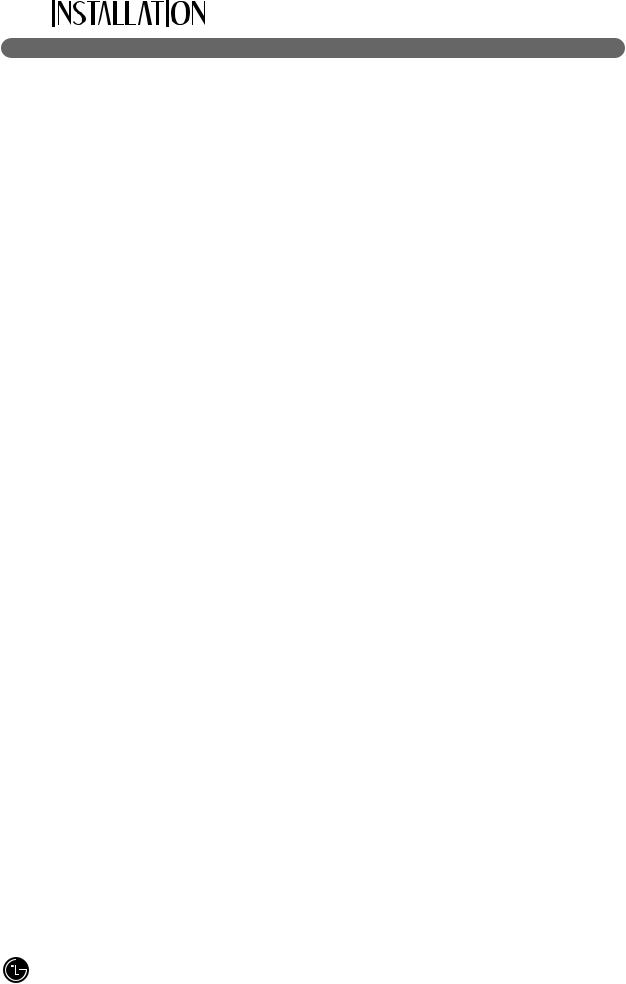
 CONNECTING THE WATER SUPPLY
CONNECTING THE WATER SUPPLY
wWARNING
Connect to safe drinking water supply only.
•The water pressure must be between 20 and 120 p.s.i. (1.4~8.4 kgf/cm2 ) on models without a water filter and between 43 and 121 p.s.i.
(3~8.5 kgf/cm2) on models with a water filter.
•If water pressure does not reach 20 psi
(1.4 kgf/cm2) or falls below, it is necessary to purchase a separate pressure pump for normal automatic icemaker and water dispensing operation.
•It is recommended that the total length of the water feed tube does not exceed 26 ft. (8 m).
•Install the water supply line where it will not be affected by heat.
•If a reverse osmosis water filtration system is connected to your cold water supply, This water line installation is not warranted by the refrigerator or icemaker manufacturer. Follow next instructions carefully to minimize the risk of expensive water damage.
•If a reverse osmosis water filtration system is connected to your cold water supply, the water pressure to the reverse osmosis system needs to be a minimum of 40 to 60 psi (2.8 kgf/cm2 ~ 4.2 kgf/cm2, less than 2.0~3.0sec to fill a cup of
7oz capacity).
If the water pressure from the reverse osmosis system is less than 20 psi (1.4 kgf/cm2, more than 4.0sec to fill a cup of 7oz capacity):
•Check to see whether the sediment filter in the reverse osmosis system is blocked. Replace the filter if necessary.
•Allow the storage tank on the reverse osmosis system to refill after heavy usage.
•If the issue about water pressure from reverse osmosis remains, call a licensed, qualified plumber.
IMPORTANT: Read all directions thoroughly before you begin.
•If operating the refrigerator before installing the water connection, turn the icemaker to the OFF position to prevent operation without water.
•All installations must be in accordance with local plumbing code requirements.
•Use copper tubing and check for leaks.
•Install tubing only in areas where temperatures will remain above freezing.
•It may take up to 24 hours for the icemaker to begin producing ice.
Tools Required
•Standard screwdriver
•7/16-in. and 1/2-in. open-end wrenches or two adjustable wrenches
•1/4-in. nut driver
•1/4-in. drill bit
•Hand drill or electric drill (properly grounded)
NOTE: Refrigerator dealers offer a kit with a 1/4-in. saddle-type shutoff valve, a union, and copper tubing. Before purchasing, make sure a saddle-type valve complies with local plumbing codes.
Do not use a piercing-type or 3/16-in. saddle valve which reduces water flow and clogs more easily.
NOTE: The Commonwealth of Massachusetts Plumbing Code 248CMR shall be adhered to.
Saddle valves are illegal and use is not permitted in Massachusetts. Consult with your licensed plumber.
Cold Water Supply
•The icemaker water valve contains a flow washer which is used as a water pressure regulator.
•The icemaker needs to be connected to a cold water line with water pressure between 20~120 psi (1.4~8.4 kgf/cm2) on models without a water filter and between 43 and 121 p.s.i. (3~8.5 kgf/cm2) on models with a water filter.

 CONNECTING THE WATER LINES
CONNECTING THE WATER LINES
IMPORTANT: Before connecting the tubing to the water line, unplug the refrigerator or disconnect the power.
•Turn off the main water supply and open the nearest faucet to relieve pressure in the line. Opening an outside faucet may help drain water from the line in the house.
•Find a 1/2-in. vertical COLD water pipe near the refrigerator.
NOTE: A horizontal pipe will work, but the following precaution must be taken: drill on the top of the pipe, not the bottom. This will help keep water away from the drill and also keep normal sediment from collecting in the valve.
•To determine the length of copper tubing you will need, measure from the connection on the lower left rear of the refrigerator to the water pipe. Add 7 ft. (2.1 m) to allow for moving the refrigerator for cleaning. Use 1/4-in. O.D. (outside diameter) copper tubing. Be sure both ends of the copper tubing are cut square.
•Using a drill, drill a 1/4-in. hole in the cold water pipe you have selected.
•Fasten the shutoff valve to the cold water pipe with the pipe clamp. Be sure the outlet end is solidly in the 1/4-in. drilled hole in the water pipe and the washer is under the pipe clamp. Tighten the packing nut. Tighten the pipe clamp screws carefully and evenly so the washer makes a watertight seal.
Do not overtighten or you may crush the copper tubing, especially if soft (coiled) copper tubing is used. Now you are ready to connect the copper tubing.
•Slip the compression sleeve and the compression nut onto the copper tubing as shown. Insert the end of the tubing into the outlet end squarely as far as it will go. Screw the compression nut onto the outlet end with a wrench. A flare nut wrench works best, but an open-end wrench will suffice. Do not overtighten.
•Place the free end of the tubing into a container or sink, and turn on the main water supply. Flush out the tubing until the water is clear. Turn off the shutoff valve on the water pipe. Coil the copper tubing as shown below.
|
Cold Water Pipe |
Packing |
Pipe Clamp |
Nut |
Coil of Polyethelyne or Copper Tubing
Shutoff
Valve
Compression |
Compression |
Sleeve |
Nut |
ENGLISH
IMPORTANT: Before connecting the tubing to the is not
|
internal water |
|
be used. |
Tubing |
1/4" |
Tubing |
|
Clamp |
|
1/4" Compression Nut 
Ferrule |
Water |
(Sleeve) |
valve |
|
Refrigerator
Connection
• Remove the plastic flexible cap from the water valve.
•Place the compression nut and ferrule (sleeve) onto the end of the tubing as shown.
•Insert the end of the copper tubing into the connection as far as possible. While holding the tubing, tighten the fitting.
IMPORTANT: Tighten any connections that leak. Open the water at the shutoff valve.
•Plug in the refrigerator.
•Arrange the coil of copper tubing behind the refrigerator so it does not vibrate against the back of the refrigerator or against the wall.
•Check for leaks.
•Before connecting the water line to house, purge the house line for 2 minute.
NOTE: It may take a few seconds for water to begin to flow as the internal tank fills and air clears from the lines.
•Push the refrigerator back to the wall.
•Set the icemaker switch to the ON position.
NOTE: The icemaker will not begin to operate until it reaches its operating temperature of 15°F (-9°C).
It will then begin operation automatically.
NOTE: Throw away the first few batches of ice (about 20 pieces).
17
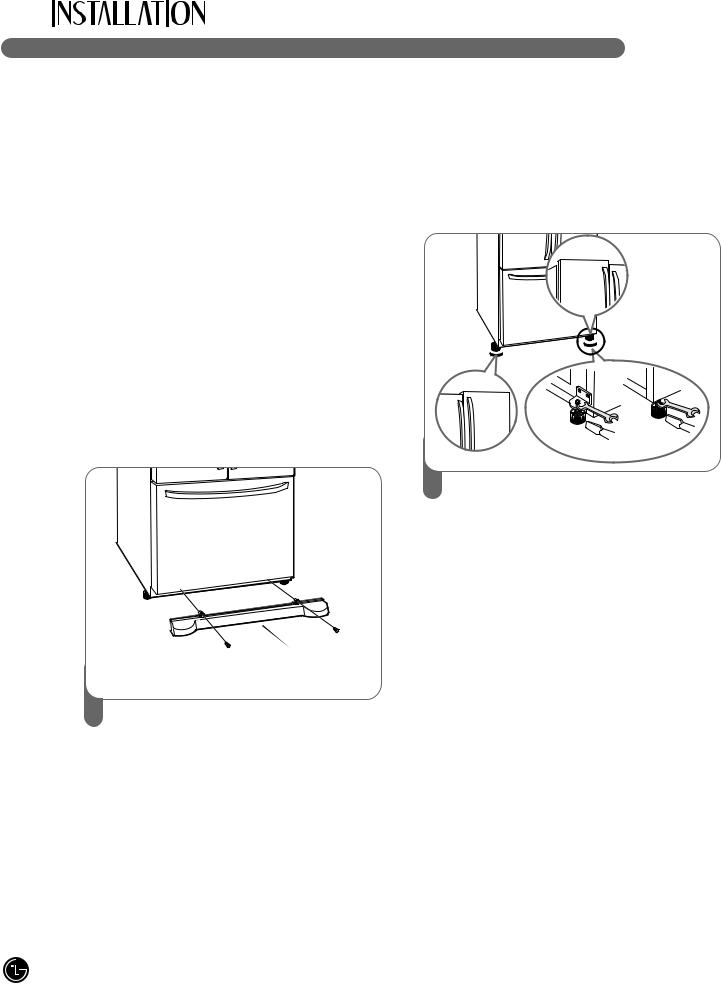
 LEVELING THE REFRIGERATOR DOORS
LEVELING THE REFRIGERATOR DOORS
wWARNING
Electrical Shock Hazard
• Be careful when you work with the hinges, grille, and stopper. You may be injured.
not put hands, feet, or metal items into air vents, base grille, or the bottom of the
. You may be injured or receive electrical shock.
installing, secure the product with the LEGS it does not move to the right or left.
refrigerator has two front leveling legs— on the right and one on the left. Adjust the to alter the tilt from front to back or side to
.If your refrigerator seems unsteady or you the doors to close more easily, adjust the
Kick Plate
wCAUTION
•To avoid possible injury or product or property damage, you will need two people to perform the following instructions.
LFC21776** LFC25776**
2
1
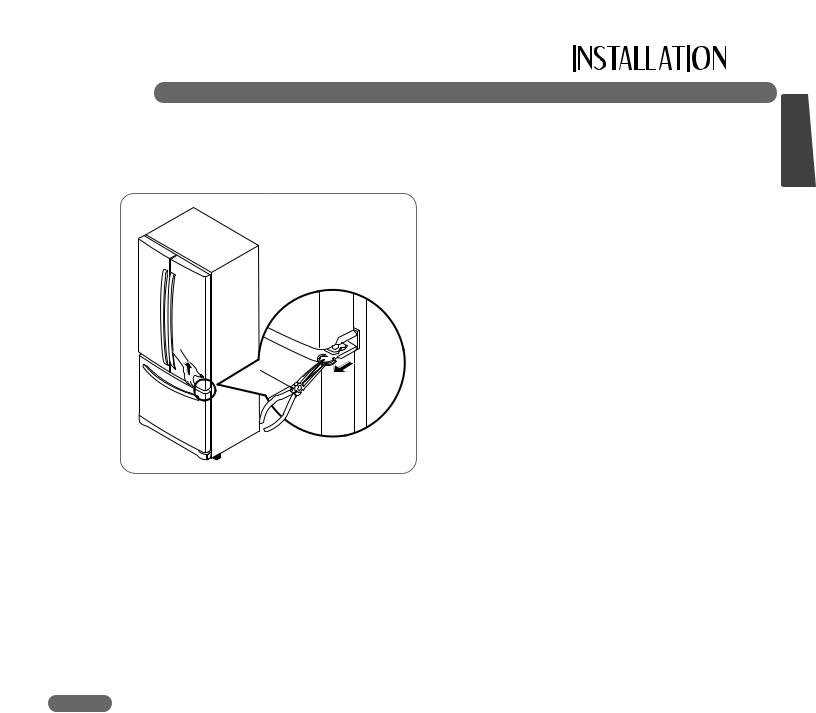
 LEVELING THE REFRIGERATOR DOORS (CONT.)
LEVELING THE REFRIGERATOR DOORS (CONT.)
DOOR
ENGLISH
STARTING
Before loading your refrigerator with fresh foods:
•Remove tape and any temporary labels from your refrigerator before using. To remove any remaining adhesive residue, rub the area briskly with your thumb, or rub a small amount of liquid dish soap over the adhesive with your fingers. Wipe with warm water and dry. Do not use sharp instruments, rubbing alcohol, flammable fluids, or abrasive cleaners to remove tape or glue.
NOTE: Do not remove any warning-type labels, the model and serial number label, or the tech sheet that is taped to the back of the refrigerator.
•Thoroughly clean your refrigerator and wipe off all dust that may have accumulated during shipping.
•Install accessories such as the ice cube bin, drawers, and shelves, in their proper places. They are packed together to prevent possible damage during shipment.
•Adjust the desired temperature for the refrigerator and freezer (see Adjusting the Temperature and Functions).
•Let your refrigerator run for at least 2 or 3 hours before putting food in it. Check the flow of cold air in the freezer compartment to ensure proper cooling. Your refrigerator is now ready for use.
19 

 SETTING THE CONTROLS
SETTING THE CONTROLS
|
|
|
|
|
|
|
|
|
|
|
|
|
|
|
|
|
|
|
|
|
|
|
|
1 |
2 |
3 |
|||
1 |
3 |
•Your refrigerator has a control pad inside the refrigerator compartment that lets you regulate the temperature in the freezer and refrigerator compartments.
•Initially set the refrigerator control at 37°F (3°C) and the freezer control at 0°F (-18°C).
Leave it at these settings for 24 hours (one day) to stabilize. Then adjust the compartment temperature as desired.
•Refrigerator Temp Control: 33°F to 46°F (0°C to 8°C)
The lower the number setting, the colder the refrigerator compartment will become.
•Freezer Temp Control: -6°F to 8°F (-21°C to -13°C)
When the setting is at a lower number, the freezer compartment becomes colder. The refrigerator compartment becomes warmer because less cold air flows into the refrigerator.
2
•When you press the ICE PLUS button, the graphic [  ] will light up in the display and it continues for 24hours. It will automatically shut off after 24hours have passed.
] will light up in the display and it continues for 24hours. It will automatically shut off after 24hours have passed.
Or you can stop this function manually by pressing the button one more time.
•This function increases both icemaking and freezing capabilities.
NOTE: If you want to change °F to °C, press and hold FREEZER key and REFRIGERATOR key over 5 seconds at the same time. and if you want to change °C to °F, hold them for 5 seconds again.
•When the power is connected to the refrigerator,
door alarm is initially set ON and door alarm display will show [  ] (ON).
] (ON).
•When either refrigerator or the freezer door is left open for more than 60 seconds, the alarm will ding to let you know the door is open.
•When you close the door, the door alarm will stop dinging.
•If you want to disable the door alarm function, press
[  ] button then the door alarm display will switched to [
] button then the door alarm display will switched to [  ] (OFF).
] (OFF).
wCAUTION
Display mode setting and its cancellation
•With the refrigerator door open, keep pressing the REFRIGERATOR Button and ICE PLUS Button more than 5 seconds, then it goes to the display mode with Special Beep Sound with special beep sound.
•Perform the same way again to cancel the display mode.
•All freezing unit will be turned off at display mode (Exceptions: Lamp, Display)
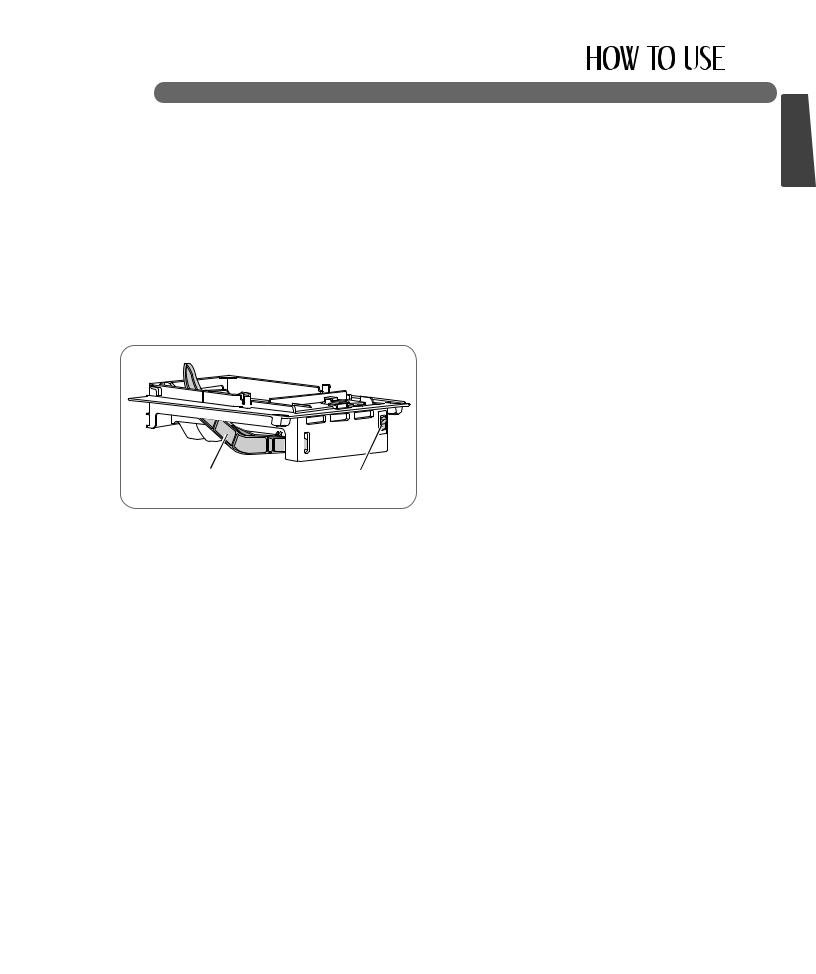
 AUTOMATIC ICEMAKER
AUTOMATIC ICEMAKER
wWARNING
Personal Injury Hazard
•DO NOT insert your hands in to the Icemaker in operation. It may cause to injure you.
Operation instructions
A newly-installed refrigerator may take 12 to 24 hours to begin making ice.
ENGLISH
NOTE: If the cube size is smaller or larger than you expected, you can regulate the size with the cube size button.
Every time you press the cube size button, the
the
Automatic Shut off Arm
Power Switch
•When the ice storage bin is removed for more than a minute or two.
•When the refrigerator will not be used for several days.
Normal sounds you may hear
•The icemaker water valve will buzz as the icemaker fills with water. If the power switch is in the I (on) position, it will buzz even if it has not yet been hooked up to water.
To stop the buzzing, move the power switch to O (off).
NOTE: Keeping the power switch in the I (on) position before the water line is connected can damage the icemaker.
•You will hear the sound of cubes dropping into the bin and water running in the pipes as the icemaker refills.
Preparing for vacation
Set the icemaker power switch to O (off) and shut off me the water supply to the refrigerator.
If the ambient temperature will drop below freezing, have a qualified servicer drain the water supply system to prevent serious property damage due to flooding from ruptured water lines or connections.
21 

 STORING FOODS
STORING FOODS
•Store fresh food in the refrigerator compartment.
•How food is frozen and thawed is an important factor in maintaining freshness and flavor.
•Do not store food that spoils easily, such as bananas and melons, at low temperatures.
•Allow hot food to cool prior to storing; placing hot food in the refrigerator could spoil other food and lead to higher energy consumption.
•When storing food, cover it with vinyl wrap or store in a container with a lid. This prevents moisture from evaporating and helps food to keep its flavor and nutrition.
•Do not block air vents with food or containers. Smooth circulation of chilled air keeps the refrigerator temperatures even.
•Do not open the doors frequently. Opening the doors allows warm air to enter the refrigerator and freezer compartments, which causes temperatures to rise.
•Never overload the door racks; overloading may push against the inner racks and prevent the doors from closing correctly.
Freezer compartment
•Do not store glass bottles in the freezer compartment; glass may break when the contents are frozen.
•Do not refreeze food that has been thawed. This causes loss of flavor and nutrition.
•Do not touch cold foods or containers, especially those made of metal, with wet hands or place glass products in the freezer compartment.
•Do not use the egg box as an ice bin in the freezer. The egg box will break easily if it freezes.
Refrigerator compartment
•Avoid placing moist food on the top refrigerator shelves; it could freeze from direct contact with chilled air.
•Always clean food prior to refrigeration. Vegetables and fruits should be washed and wiped and packed food should be wiped to prevent adjacent food from spoiling.
NOTE: If you keep the refrigerator in a hot and humid place, frequent opening of the door or storing a lot of vegetables in the refrigerator may cause condensation to form. Wipe the condensation with a clean cloth or a paper towel.
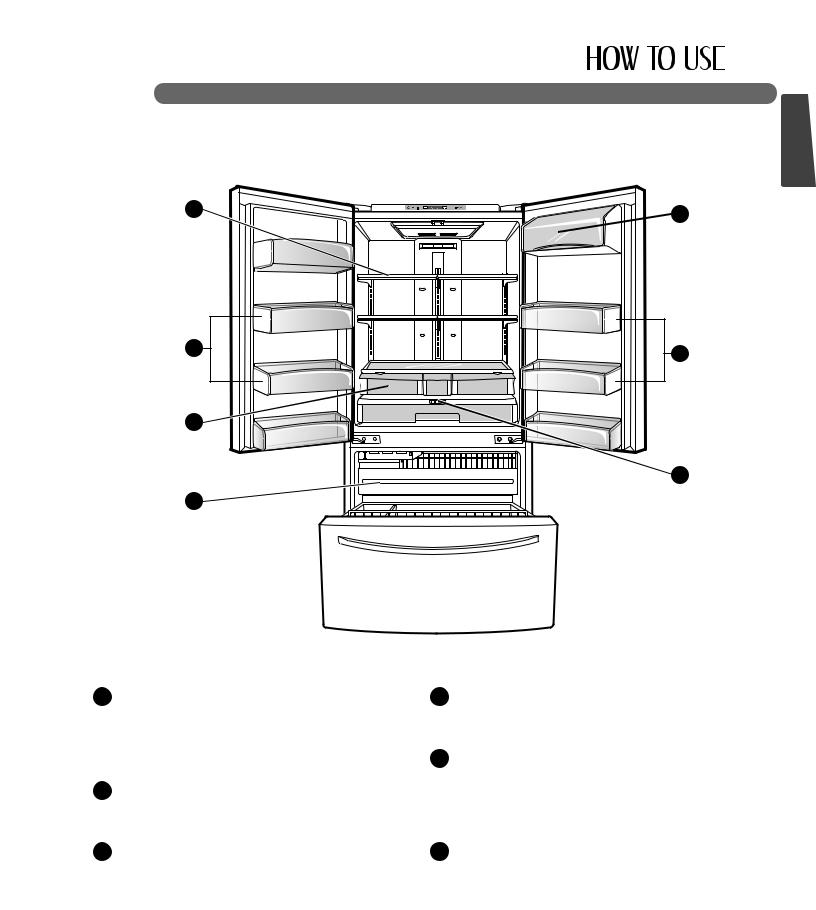
 LOCATION OF FOODS
LOCATION OF FOODS
|
1 |
|
4 |
|
|
|
|
|
5 |
|
5 |
|
|
|
|
|
2 |
|
|
|
|
|
6 |
|
3 |
|
|
1 |
|
4 |
CORNER |
|
Store larger food items, platters, and containers |
|
Store milk products such as butter and cheese. |
|
on the expansive refrigerator compartment |
|
|
|
shelves. |
5 |
GALLON STORAGE BINS |
|
|
2 |
CRISPERS |
Store small packed food or beverages such as |
condiments, salad dressings, baby foods, milk, or |
||
|
Store vegetables or fruits with humidity control. |
juice. |
3 |
|
GLIDE‘N’SERVE |
|
Store small packed frozen food, or store meat, |
Provides storage space with a variable temperature |
|
fish, and chicken after wrapping them with thin |
control that keeps the compartment colder than |
|
foil. Store dry. |
refrigerator. |
ENGLISH
23 
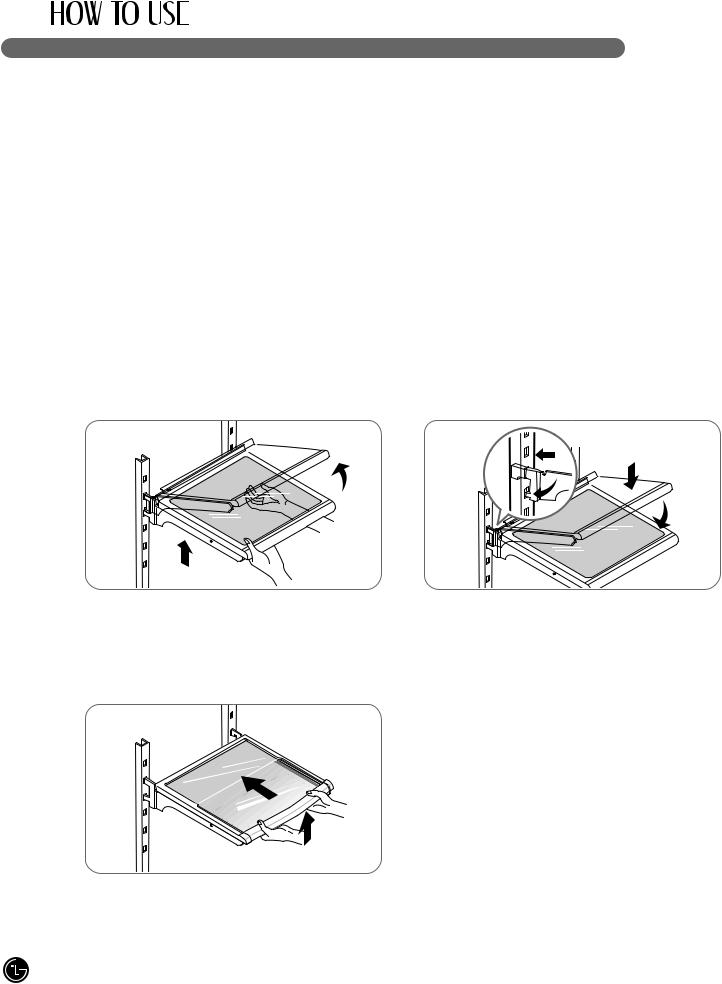
 SHELF HEIGHT ADJUSTMENT
SHELF HEIGHT ADJUSTMENT
The shelves in your refrigerator are adjustable to meet your individual storage needs.
Storing similar food items together in your refrigerator and adjusting the shelves to fit different heights of items will make finding the exact item you want easier; it will also reduce the amount of time the refrigerator door is open, saving energy.
IMPORTANT: Do not clean glass shelves with warm water when they are cold. Shelves may break if exposed to sudden temperature changes or impact, such as bumping. For your protection, glass shelves are made with tempered glass, which will shatter into small, pebble-sized pieces.
Remove Shelf
Folding Shelf
NOTE: Glass shelves are heavy. Use special care when removing them to avoid dropping them.
Adjusting Shelves
Remove shelves from the shipping position and place shelves in the position you want.
wCAUTION
Make sure that shelves are level from one side to the other. Failure to do so may result in the shelf’s falling or spilling food.
Reinstall Shelf
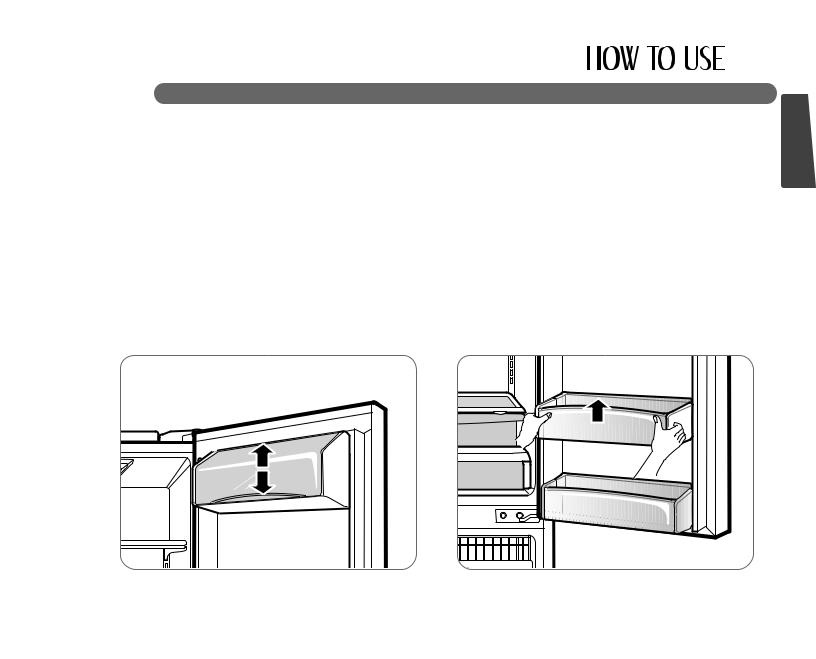
 REMOVING AND REPLACING COMPONENTS
REMOVING AND REPLACING COMPONENTS
NOTE: When reinstalling components, reverse the order of steps for removal. To prevent damage, never use excessive force when removing or reinstalling components.
wCAUTION
•Personal injury can occur if the door bins are not firmly assembled.
NOTE: DO NOT adjust a loaded bin.
•DO NOT allow children to play with baskets. The sharp corners on the baskets could cause injury.
Dairy Bin |
Gallon Storage Bins |
ENGLISH
25 
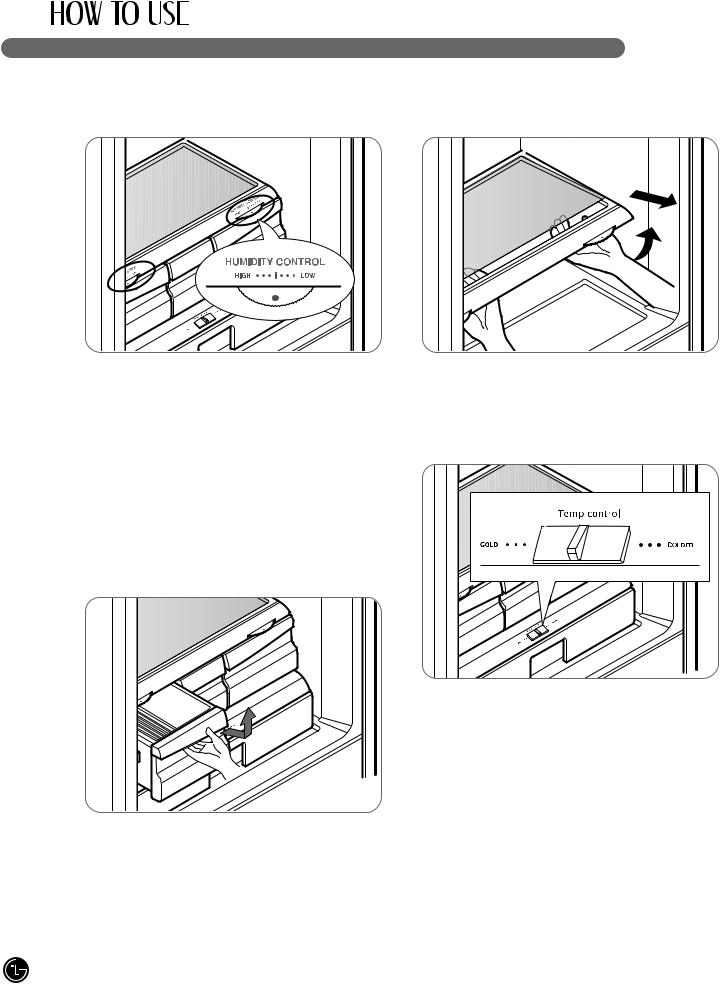
 REMOVING AND REPLACING COMPONENTS (CONT.)
REMOVING AND REPLACING COMPONENTS (CONT.)
Crisper humidity control |
To remove the glass |
Glide‘N’Serve
Removing crisper
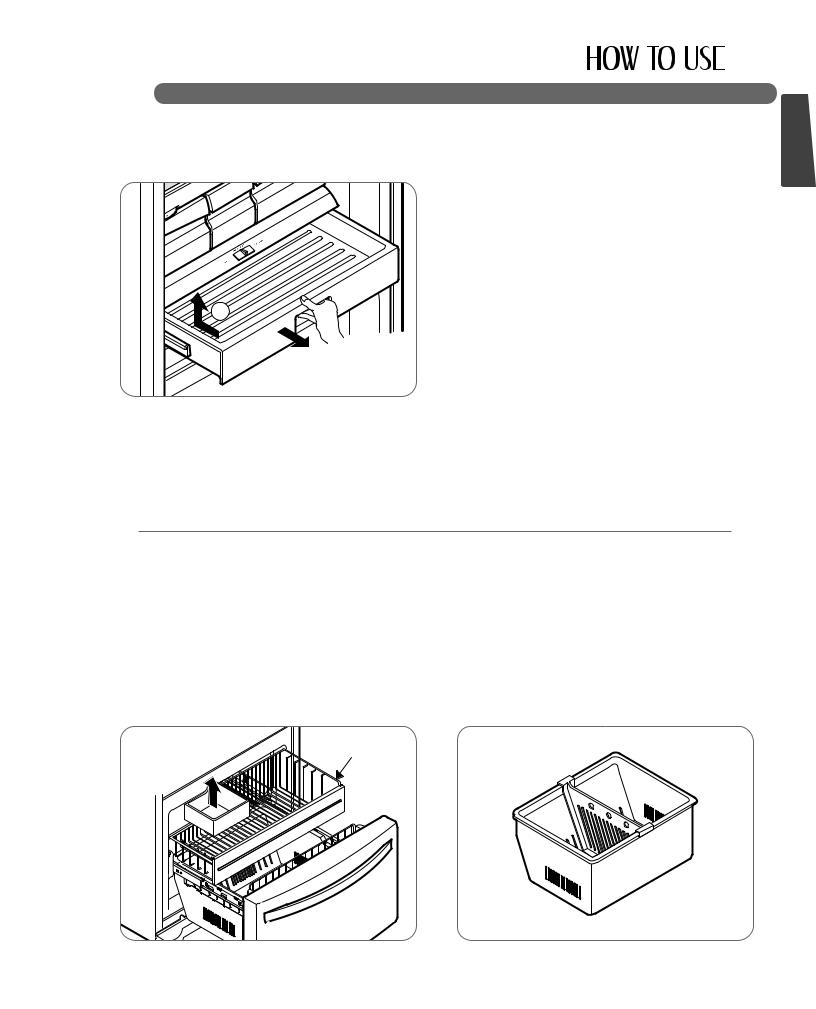
 REMOVING AND REPLACING COMPONENTS (CONT.)
REMOVING AND REPLACING COMPONENTS (CONT.)
To replace Glide‘N’Serve |
wCAUTION |
|
• When you close the refrigerator door with GLIDE'N'SERVE DRAWER opened, that the drawer could be broken.
NOTE: Removing the fixed door bin is recommended to reduce the risk of door bin scratches.
ENGLISH
wCAUTION
•Pinch hazard! Keep hands and feet clear of the bottom of the door when opening and closing.
Ice Bin
Drawer
wWARNING
Child Entrapment Hazard
•If the Durabase divider is removed, there is enough open space for children or pets to crawl inside.
To prevent accidental child and pet entrapment or suffocation risk, DO NOT allow them to play inside of drawer.
DuraBase ® Divider
27 

 REMOVING AND REPLACING COMPONENTS (CONT.)
REMOVING AND REPLACING COMPONENTS (CONT.)
Tilt-Out Door Basket (LFC25776**)
1 |
2 |
Pull-Out Drawer
Bracket
1 |
2 |
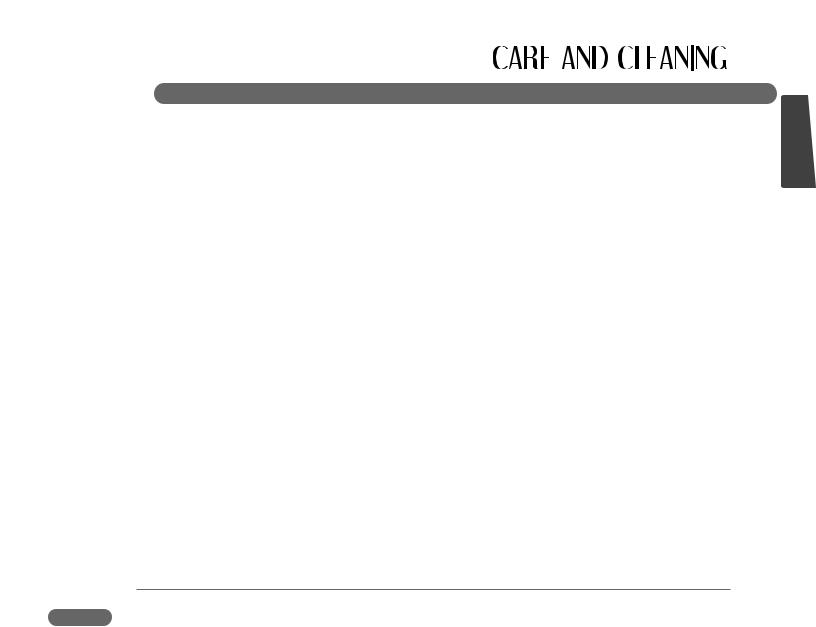
 CLEANING THE REFRIGERATOR
CLEANING THE REFRIGERATOR
wWARNING
Explosion Hazard
•Use nonflammable cleaner.
•Failure to do so can result in death, explosion, or fire.
Both the refrigerator and freezer sections defrost automatically. However, clean both sections about once a month to prevent odors. Wipe up spills immediately.
•Unplug the refrigerator.
•Remove all removable parts, such as shelves and crispers.
•Use a clean sponge or soft cloth and a mild detergent in warm water. Do not use abrasive or harsh cleaners.
•Hand wash, rinse, and thoroughly dry all surfaces.
•Plug in the refrigerator.
NOTE: Window sprays, abrasive cleaners, or flammable fluids can scratch or damage plastic covers or panels.
Cleaning the Exterior
For models with a stainless steel exterior, use a commercially available stainless steel cleaner in accordance with the manufacturer’s instructions.
You may also use a clean sponge or soft cloth and a mild detergent in warm water. Do not use abrasive or harsh cleaners. Dry thoroughly with a soft cloth.
IMPORTANT: Do not use cleaning waxes, concentrated detergents, or cleaners containing petroleum on plastic refrigerator parts such as door liners or gaskets.
Care and Cleaning of the Interior
NOTE: Allow the freezer to warm so the cleaning cloth will not stick.
To help remove odors, you can wash the inside of the refrigerator with a mixture of baking soda and warm water. Mix 2 tbsp. baking soda to 1 qt. of water (26 g soda to 1 L of water). Be sure the baking soda dissolves completely so it does not scratch the surfaces of the refrigerator.
IMPORTANT: Do not use a spray nozzle to clean the interior.
ENGLISH
GENERAL INFORMATION
Storage
During average-length vacations, you will probably find it best to leave the refrigerator in operation. Place freezable items in the freezer for longer life.
When you plan to store the refrigerator, remove all food, disconnect the power cord, clean the interior thoroughly, and block the doors open to prevent mold and mildew. Be certain the stored refrigerator does not present a child entrapment danger.
Moving
Unload the refrigerator to move it. (This is probably not necessary when pulling it out to clean behind it.) Be sure to let the refrigerator warm up to room temperature, and dry the inside before closing the doors to pack it for moving. To avoid damaging the height-adjusting screws, turn them all the way into the base.
Power Failure
Most power failures that are corrected within an hour or two will not affect your refrigerator temperatures. However, you should minimize the number of door openings while the power is off.
Water may drip from the ice bin during a power outage. To prevent this, remove the ice bin, discard all of the ice, towel dry, and replace.
29 

 BEFORE CALLING FOR SERVICE
BEFORE CALLING FOR SERVICE
Before calling for service, review this list. It may save you both time and expense. This list includes common occurrences that are not the result of defective workmanship or materials in this appliance.
Problem
Refrigerator compressor does not run.
Refrigerator compressor runs too frequently or too long.
Refrigerator compressor cycles on and off.
Temperature in the freezer is too cold, but the refrigerator temperature is satisfactory.
Temperature in the refrigerator is too cold, but the freezer temperature is satisfactory.
Possible Causes
•Refrigerator control is off.
•Refrigerator is in defrost cycle.
•Plug at the wall outlet is disconnected.
•Power outage. Check house lights.
•Refrigerator is larger than the previous one you owned.
•The room or the outdoor weather is hot.
•Refrigerator was recently disconnected for a while.
•Large amounts of warm or hot food may have been stored recently.
•Doors are opened too frequently or for too long.
•Refrigerator or freezer door may be slightly open.
•Refrigerator control is set too cold.
•Refrigerator or freezer gasket is dirty, worn, cracked, or poorly fitted.
•The thermostat is keeping the refrigerator at a constant temperature.
•Freezer control is set too cold.
•Refrigerator control is set too cold.
Solutions
•Set the refrigerator control.
•This is normal for a fully automatic defrosting refrigerator. The defrost cycle occurs periodically.
•Make sure the plug is tightly pushed into the outlet.
•Call the local electric company.
•This is normal. Larger, more efficient units run longer.
•It is normal for the refrigerator to work longer under these conditions.
•It takes a few hours for the refrigerator to reach cooling temperatures.
•Warm food will cause the refrigerator to run longer until the desired temperature is reached.
•Warm air entering the refrigerator causes it to run more. Open the door less often.
•Make sure the refrigerator is level. Keep food and containers from blocking the door.
•Adjust the refrigerator control to a warmer setting until the refrigerator temperature is satisfactory.
•Clean or change the gasket. Leaks in the door seal will cause the refrigerator to run longer in order to maintain desired temperatures.
•This is normal. The refrigerator cycles on and off to keep the temperature constant.
•Adjust the freezer control to a warmer setting until the freezer temperature is satisfactory.
• Adjust the refrigerator control to a warmer setting.
